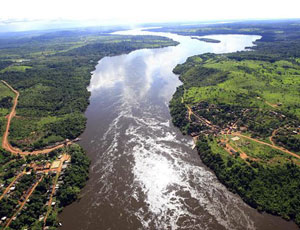A controversial 11,200-MW hydroelectric dam deep in the Brazilian Amazon was awarded to a nine-company consortium on April 20, setting aside years of controversy and last-minute protests.

Brazil’s electricity regulating agency Aneel awarded the tender to build and operate Belo Monte dam to the Norte Energia Consortium led by Compañía Hidro Eletrica do Sao Francisco (CHESF), a unit of state-run Centrais Eletricas Brasileiras SA. The group presented an offer to sell electricity from the project for 77.97 reais, or $44.24, per megawatt-hour.
The other companies in the consortium include Galvão, Galvão Engenharia, Junior Trading Engenharia, Serveng-Civilsan, J. Malucelli Construtora de Obras, Contern Construções e Comércio, Cetenco Engenharia and Gaia Energia e Participações.
The run-of-river dam, which will cost an estimated $11 billion, will be built on the Xingu River, a major Amazon tributary in the northern state of Para. The five-year project is scheduled to be complete as early as 2015. When completed, it will be surpassed in size only by China’s immense 22.5-GW Three Gorges scheme and the massive 14-GW Itapu facility on the border of Brazil and Paraguay.
The project will involve construction of a dam that will force much of the water to bypass a major bend in the Xingu; instead, the water would be diverted through two 500-meter canals to a powerhouse and turbines at another area of the river. Plans for the project have been modified to reduce by two-thirds the land needed for the reservoir. In turn, this strategy will slash the output of the hydroelectric project by as much as 40% during the dry season, when the water levels of the Xingu River drop precipitously. The average output during that period is expected to be in the range of 3,500 MW to 4,500 MW.
The Belo Monte auction had been bitterly opposed by indigenous groups who would be displaced by the project and by environmentalists. The Belo Monte plans call for flooding at least 440 sq kilometers.
Public protests intensified in the weeks leading up to the auction and a bitter legal battle to block the proceeding—including no fewer than three injunctions—was resolved only minutes before the contract was awarded. The consortium will be required to pay for the relocation of residents who will be displaced by the project as well as paying $800 million to protect the environment.
Brazil has pushed the project as a critical piece of the nation’s growing power generation needs. At peak operation, the dam will be able to produce 6% of the country’s electricity needs.
Participation in the auction was also controversial. Norte Energia’s sole competition for the project, the Belo Monte Consortium, comprised state-owned Eletrosul Centrais Eletricas SA, construction company Andrade Gutierrez Participações, mining giant Vale SA, Furnas Centrais Eletricas, Companhia Brasileira de Alumínio and Eletrosul Centrais Elétricas.
Significant hurdles still remain for the project. Federal prosecutors who unsuccessfully tried to garner an injunction to stop the auction have said they will seek to have the proceeding declared null and void. While the project has its major environmental permit, Norte Energia Consortium must still obtain permits from the country's environmental ministry to proceed with construction.
The competition for the project suffered a setback a week prior to the auction when a group composed of Brazil’s two largest construction firms, Odebrecht and Camargo Correa, pulled out of the bidding. The companies cited the government’s energy-price cap of 83 reais, or $47.13, per megawatt-hour as making the project too risky.
To ensure participation of the remaining consortia, the government promised a 75% income-tax break and better financing terms from the state development bank.
Belo Monte isn’t the first hydroelectric scheme undertaken in Brazil using a run-of-the-river approach. Two of the largest run-of-the-river hydroelectric dams ever attempted are under construction on the Madiera River in the state of Rondonia. The San Antonio and Jirau hydro projects will produce a combined 6,440 MW when completed by 2015.


Post a comment to this article
Report Abusive Comment